Mechanical Properties of Cement Mortar Containing Ground Waste Newspaper as Cementitious Material
Abstract
1. Introduction
2. Experimental Materials and Methods
2.1. Materials
2.2. Mixing Proportions and Testing Methods
3. Results and Discussion
3.1. Mortar Flow
3.2. Compressive Strength
3.3. Split Tensile Strength
3.4. Carbonation Resistance
3.5. Drying Shrinkage
3.6. Microstructural Analysis
4. Conclusions
- Mortar flow gradually decreased as the WNP mixing ratio increased. This may be attributed to the fact that cellulose, which is the main component of WNP, is a hydrophilic material with high water absorbency. Thus, it absorbed water during mixing and the flow subsequently decreased.
- The early compressive strength of the sample containing WNP was lower than that of the control sample, and strength increased afterwards. This may be attributed to the fact that initial hydration was delayed due to the high water absorption of WNP and the increase in micropores. In addition, the tendency to increase strength may be caused by the release of absorbed moisture, which thus promotes hydration; hydration products may form on the cellulose surface to fill pores, resulting in a dense structure.
- The 28-day accelerated carbonation depth of the samples with WNP was approximately 1.03–1.61 mm, and their carbonation resistance was approximately 5.2–39.4% higher than that of the control sample.
- It was confirmed that compressive strength, tensile strength, and carbonation resistance were improved by utilizing ground WNP as a cement substitute in mortar. In this study, the appropriate amount of WNP according to the mechanical properties of cement mortar was found to be 0.4–0.8%, and considering durability characteristics, 0.6% WNP was the optimal value.
Author Contributions
Funding
Institutional Review Board Statement
Informed Consent Statement
Data Availability Statement
Acknowledgments
Conflicts of Interest
References
- Lee, J.I.; Bae, S.H.; Kim, J.H.; Choi, S.J. Effect of cementitious materials on the engineering properties of lightweight aggregate mortars containing recycled water. Materials 2022, 15, 1967. [Google Scholar] [CrossRef] [PubMed]
- Nowotna, A.; Pietruszka, B.; Lisowski, P. Eco-friendly building materials. IOP Conf. Ser. Earth Environ. Sci. 2019, 290, 012024. [Google Scholar] [CrossRef]
- Jang, N.C. Improvements of the Renewable Energy Legislation for the realization of 2050 carbon neutral. Justice 2022, 190, 5–27. [Google Scholar]
- Talaei, A.; Pier, D.; Lyer, A.V.; Ahiduzzaman, M.; Kumar, A. Assessment of long-term energy efficiency improvement and greenhouse gas emissions mitigation options for the cement industry. Energy 2019, 170, 1051–1066. [Google Scholar] [CrossRef]
- Charith, H.; Chamila, G.; David, W.L.; Sujeeva, S. Performance of high volume fly ash concrete incorporating additives: A systematic literature review. Constr. Build. Mater. 2020, 258, 120606. [Google Scholar]
- Mugahed, A.; Solomon, D.; Togay, O. Fly ash-based eco-friendly geopolymer concrete: A critical review of the long-term durability properties. Constr. Build. Mater. 2021, 270, 121857. [Google Scholar]
- Quang, D.N.; Khan, M.S.H.; Arnaud, C.; Kim, T. Durability and microstructure properties of low-carbon concrete incorporating ferronickel slag sand and fly ash. J. Mater. Civ. Eng. 2019, 31, 04019152. [Google Scholar]
- Erdogan, O.; Mustafa, E.; Halil, I.D. Utilization and efficiency of ground granulated blast furnace slag on concrete properties-A review. Constr. Build. Mater. 2016, 105, 423–434. [Google Scholar]
- Dinakar, P.; Kali, P.S.; Umesh, C.S. Design of self-compacting concrete with ground granulated blast furnace slag. Mater. Des. 2013, 43, 161–169. [Google Scholar] [CrossRef]
- Ali, R.B.; Hamed, Z.; Mohamad, M.M. Mechanical and durability properties of ternary concretes containing silica fume and low reactivity blast furnace slag. Cem. Concr. Compos. 2012, 34, 663–670. [Google Scholar]
- Jung, J.H.; Seo, S.K.; Chu, Y.S. A study on pretreated paper sludge ash for cement admixture. J. Korean Inst. Resour. Recycl. 2016, 25, 58–64. [Google Scholar]
- Ko, J.C.; Kim, S.H.; Park, Y.K.; Jeon, J.Y.; Kim, J.H.; Park, J.S. Pyrolysis characteristics of sludge discharged from paper mill process. J. Korea Org. Resour. Recycl. Assoc. 2009, 17, 80–87. [Google Scholar]
- Sudha, J.L.; Sagar, D.S.V.S.R.; Ram, R.J. Experimental studies on strength characteristics of concrete with waste paper sludge ash as partial replacement for cement. Int. J. Res. Anal. Rev. 2018, 5, 342–347. [Google Scholar]
- Shabbir, F.; Ejaz, N.; Khan, D.; Ahmad, N.; Hussain, J. Investigation of using paper industry waste (hypo sludge) in concrete mix. J. Eng. Appl. Sci. 2015, 34, 7–12. [Google Scholar]
- Garcia, R.; Villa, R.V.; Frias, M.; Rojas, M.I.S. The pozzolanic properties of paper sludge waste. Constr. Build. Mater. 2008, 22, 1484–1490. [Google Scholar] [CrossRef]
- Hong, S.W.; Robert, B.; Abdulla, A.; Mohamed, S. Hydrophobic concrete using waste paper sludge ash. Cem. Concr. Res. 2015, 70, 9–20. [Google Scholar]
- Bui, N.K.; Satomi, T.; Takahashi, H. Influence of industrial by-products and waste paper sludge ash on properties of recycled aggregate concrete. J. Clean. Prod. 2019, 214, 403–418. [Google Scholar] [CrossRef]
- Fedorov, V.; Mestnikov, A. Influence of cellulose fibers on structure and properties of fiber reinforced foam concrete. MATEC Web Conf. 2018, 143, 02008. [Google Scholar] [CrossRef]
- Wang, Z.; Li, H.; Jiang, Z. Effect of waste paper fiber on properties of cement-based mortar and relative mechanism. Mater. Sci. Ed. 2018, 33, 419–426. [Google Scholar] [CrossRef]
- Liu, J.; Lv, C. Research progress on durability of cellulose fiber-reinforced cement-based composites. Int. J. Polym. Sci. 2021, 2021, 1014531. [Google Scholar] [CrossRef]
- Lyu, H.S.; Lee, S.S.; Kwon, S.J. Evaluation of workability and strength in concrete with cellulose fibers. J. Rec. Const. Res. Inst. 2020, 8, 198–203. [Google Scholar]
- Nasir, M.; Aziz, M.A.; Zubair, M.; Ashraf, N.; Hussein, T.N.; Allubli, M.K.; Manzar, M.S.; Al-Kutti, W.; Al-Harthi, M.A. Engineered cellulose nanocrystals-based cement mortar from office paper waste: Flow, strength, microstructure, and thermal properties. J. Build. Eng. 2022, 51, 104345. [Google Scholar] [CrossRef]
- KS F 2403; Standard Test Method for Making and Curing Concrete Specimens. Korean Standards & Certification Information Center: Seoul, Republic of Korea, 2019.
- KS L 5105; Testing Method for Compressive Strength of Hydraulic Cement Mortars. Korean Standards & Certification Information Center: Seoul, Republic of Korea, 2007.
- KS F 2423; Standard Test Method for Tensile Splitting Strength of Concrete. Korean Standards & Certification Information Center: Seoul, Republic of Korea, 2011.
- KS F 2584; Standard Test Method for Accelerated Carbonation of Concrete. Korean Standards & Certification Information Center: Seoul, Republic of Korea, 2015.
- KS F 2424; Standard Test Method for Length Change of Mortar and Concrete. Korean Standards & Certification Information Center: Seoul, Republic of Korea, 2015.
- Singh, H.; Gupta, R. Influence of cellulose fiber addition on self-healing and water permeability of concrete. Case Stud. Constr. Mater. 2020, 12, e00324. [Google Scholar] [CrossRef]
- Salem, R.M.; Al-Salami, A.E. Preparation of waste paper fibrous cement and studying of some physical properties. Civ. Environ. Res. 2016, 8, 42–54. [Google Scholar]
- Xuan, M.Y.; Wang, X.Y. Multi-technique investigation regarding the impact of cellulose nanofibers on ultra-high-performance concrete at the macroscopic and microscopic levels. Constr. Build. Mater. 2022, 327, 126936. [Google Scholar] [CrossRef]
- Bai, J.; Chaipanich, A.; Kinuthia, J.M.; O’Farrell, M.; Sabir, B.B.; Wild, S.; Lewis, M.H. Compressive strength and hydration of wastepaper sludge ash-ground granulated blastfurnace slag blended pastes. Cem. Concr. Res. 2003, 33, 1189–1202. [Google Scholar] [CrossRef]
- Jiang, Z.; Guo, X.; Li, W.; Chen, Q. Self-shrinkage behaviors of waste paper fiber reinforced cement paste considering its self-curing effect at early-ages. Int. J. Polym. Sci. 2016, 2016, 8690967. [Google Scholar] [CrossRef]
- Yaro, N.S.A.; Napiah, M.B.; Sutanto, M.H.; Usman, A.; Saeed, S.M. Performance evaluation of waste palm oil fiber reinforced stone matrix asphalt mixtures using traditional and sequential mixing processes. Case Stud. Constr. Mater. 2021, 15, e00783. [Google Scholar] [CrossRef]
- Kubba, H.Z.; Nasr, M.S.; Al-Abadaly, N.M.; Dhahir, M.K.; Najim, W.N. Influence of incinerated and non-incinerated waste paper on properties of cement mortar. IOP Conf. Ser. Mater. Sci. Eng. 2019, 671, 012113. [Google Scholar] [CrossRef]
- Park, Y.K.; Lee, J.H.; Jeon, I.K.; Kim, H.W.; Yoon, K.W. Evaluation of the basic properties of concrete with types on cellulose fibers. J. Korea Inst. Build. Constr. 2011, 11, 419–425. [Google Scholar] [CrossRef]
- Chen, Y.; Liu, P.; Yu, Z. Effect of environmental factors on concrete carbonation depth and compressive strength. Materials 2018, 11, 2167. [Google Scholar] [CrossRef] [PubMed]
- Filho, A.S.; Parveen, S.; Rana, S.; Vanderlei, R.; Fangueiro, R. Micro-structure and mechanical properties of microcrystalline cellulose-sisal fiber reinforced cementitious composites developed using cetyltrimethylammonium bromide as the dispersing agent. Cellulose 2021, 28, 1663–1686. [Google Scholar] [CrossRef]
- Kawashima, S.; Shah, S.P. Early-age autogenous and drying shrinkage behavior of cellulose fiber-reinforced cementitious materials. Cem. Concr. Compos. 2011, 33, 201–208. [Google Scholar] [CrossRef]
- Mei, C.T.; Jiang, L.Y.; Jiang, M.M.; Zhou, X.L.; Huang, H. Modification of cellulose extracted from waste newspaper. IOP Conf. Ser. Earth Environ. Sci. 2019, 295, 032009. [Google Scholar] [CrossRef]
- Srasri, K.; Thongroj, M.; Chaijiraaree, P.; Thiangtham, S.; Manuspiya, H.; Pisitsak, P.; Ummartyotin, S. Recovery potential of cellulose fiber from newspaper waste: An approach on magnetic cellulose aerogel for dye adsorption material. Int. J. Biol. Macromol. 2018, 119, 662–668. [Google Scholar] [CrossRef]
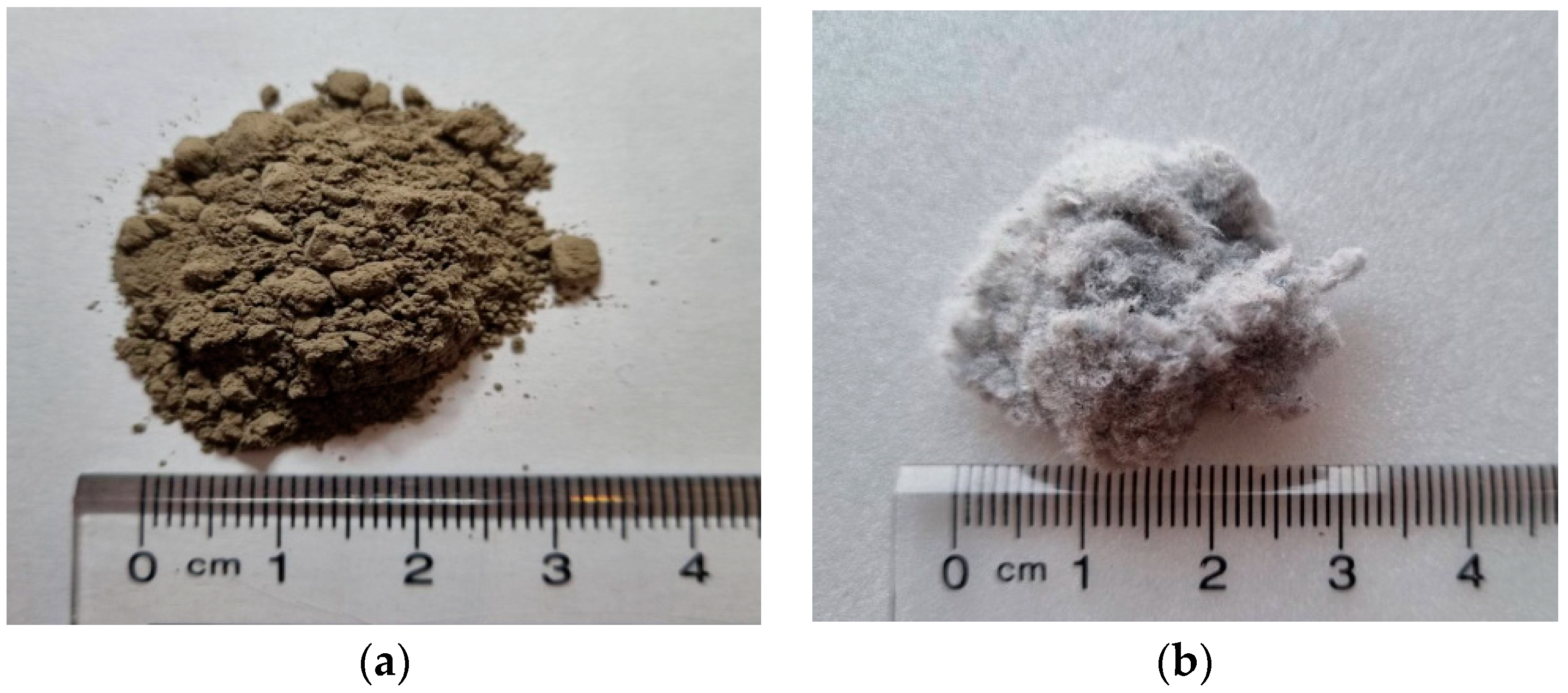
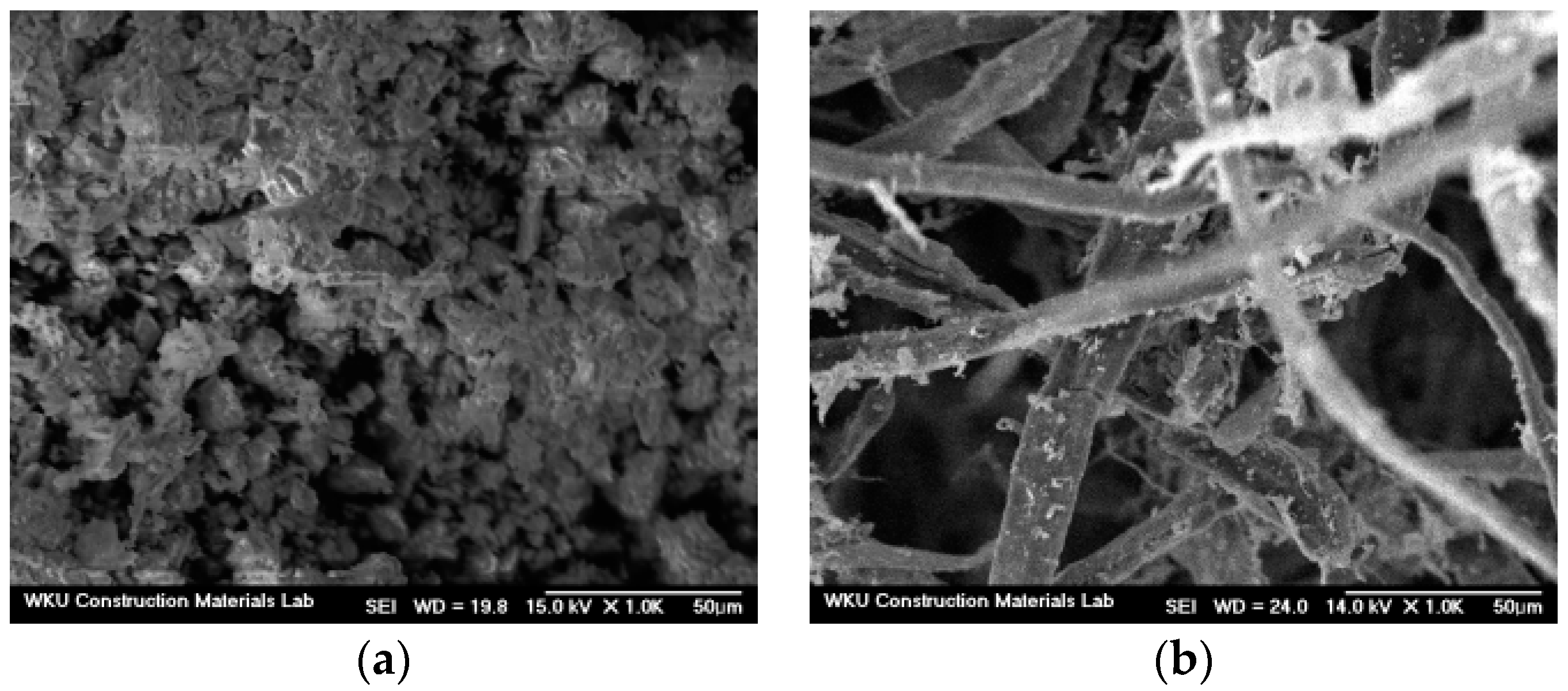
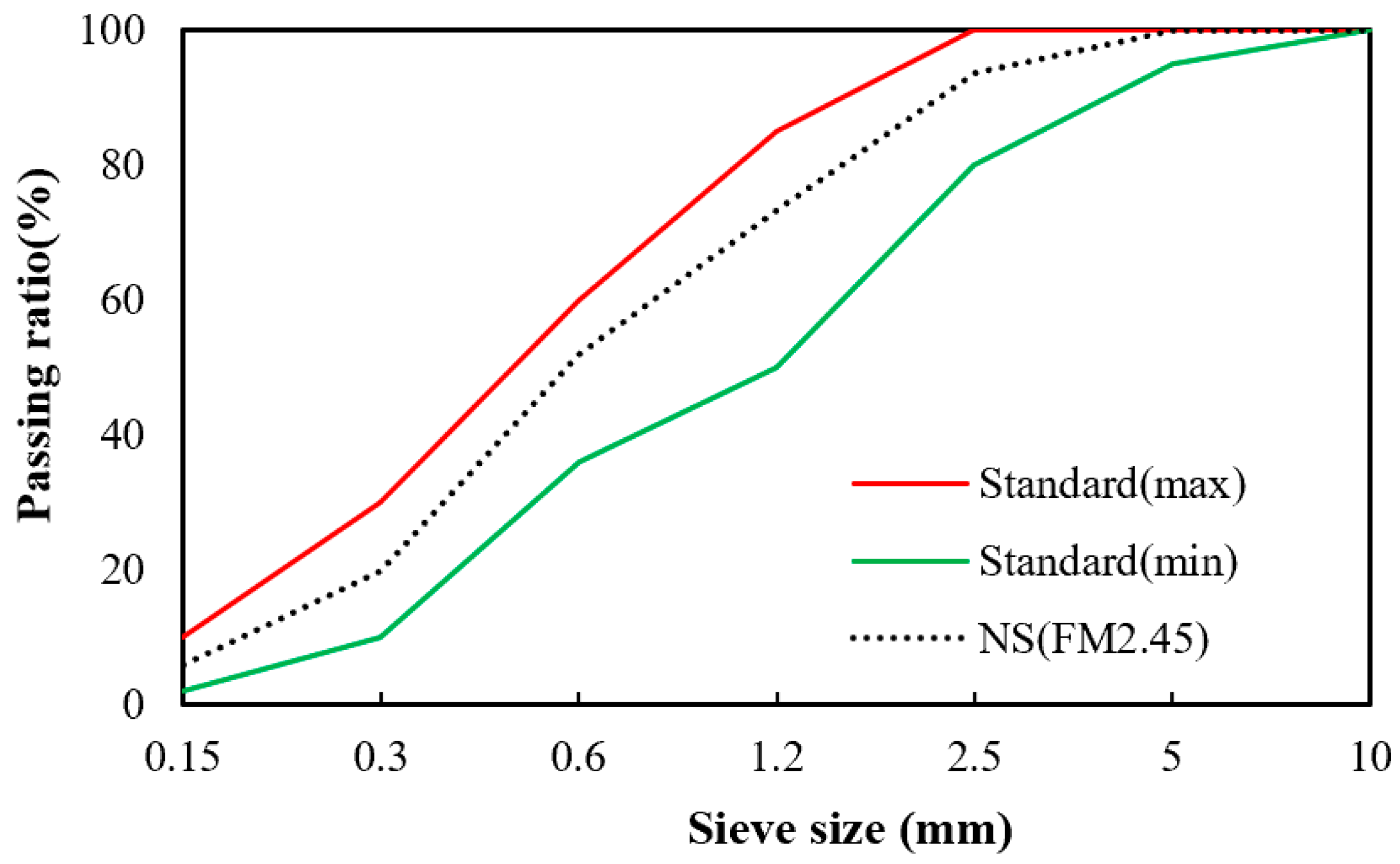



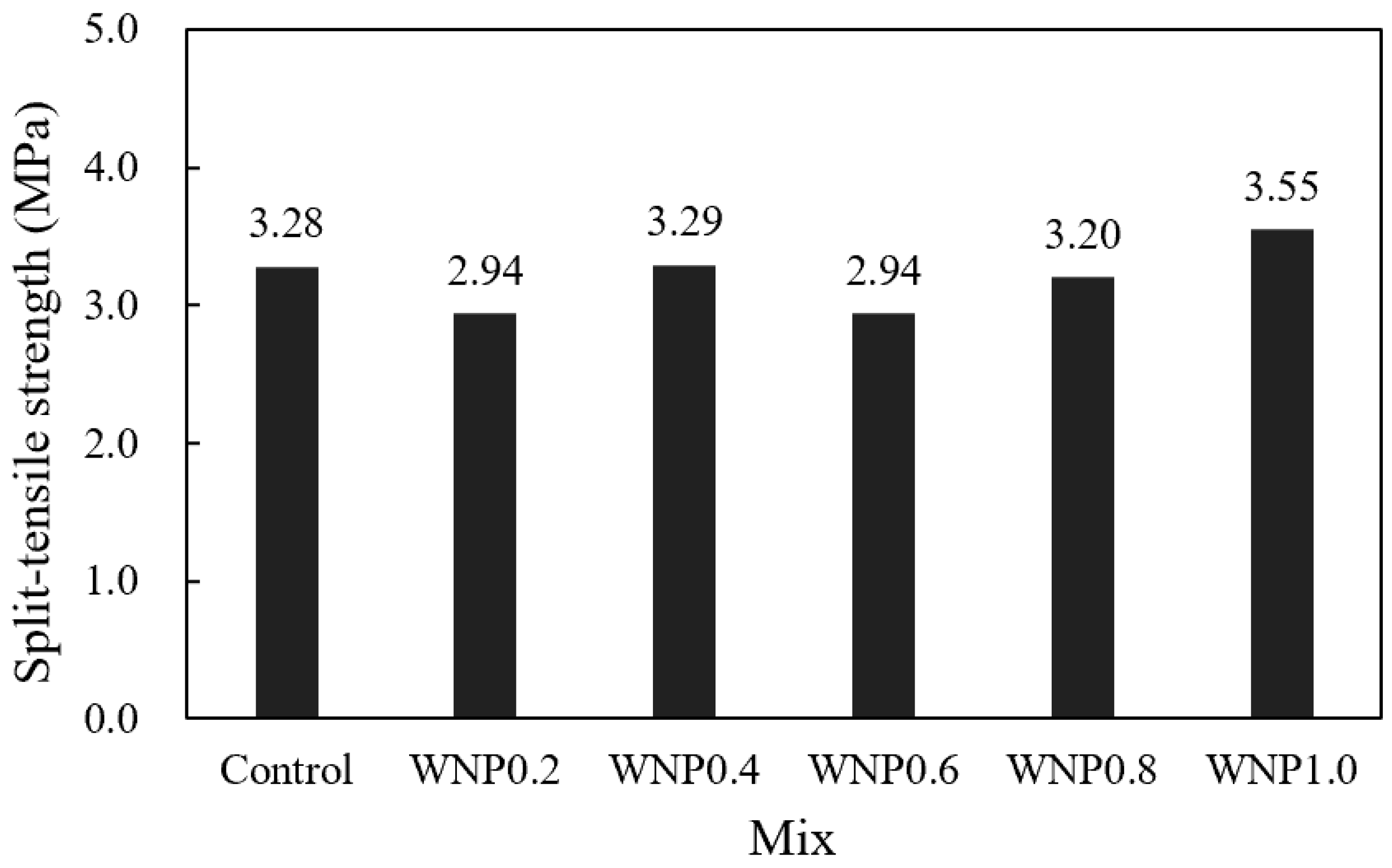
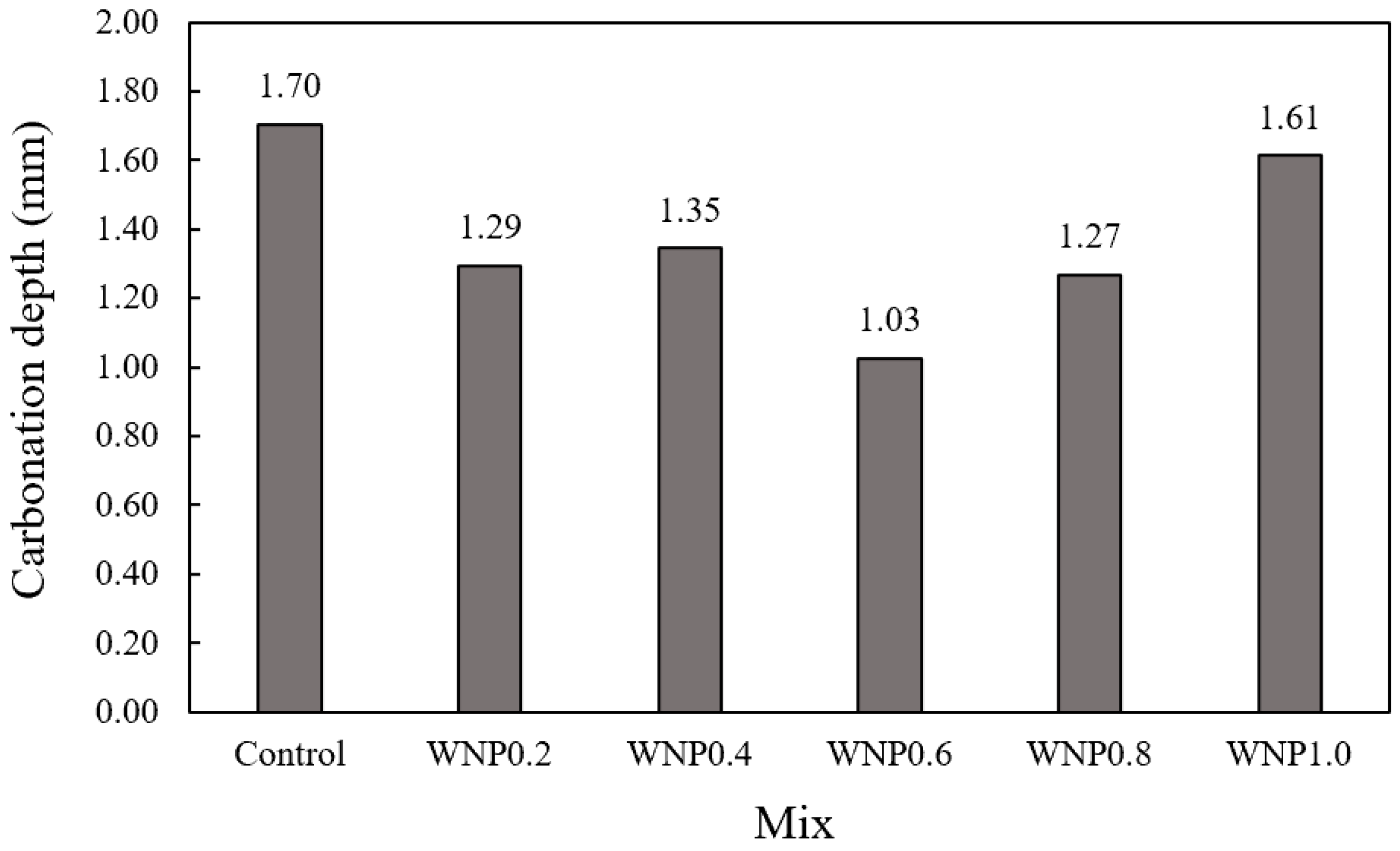
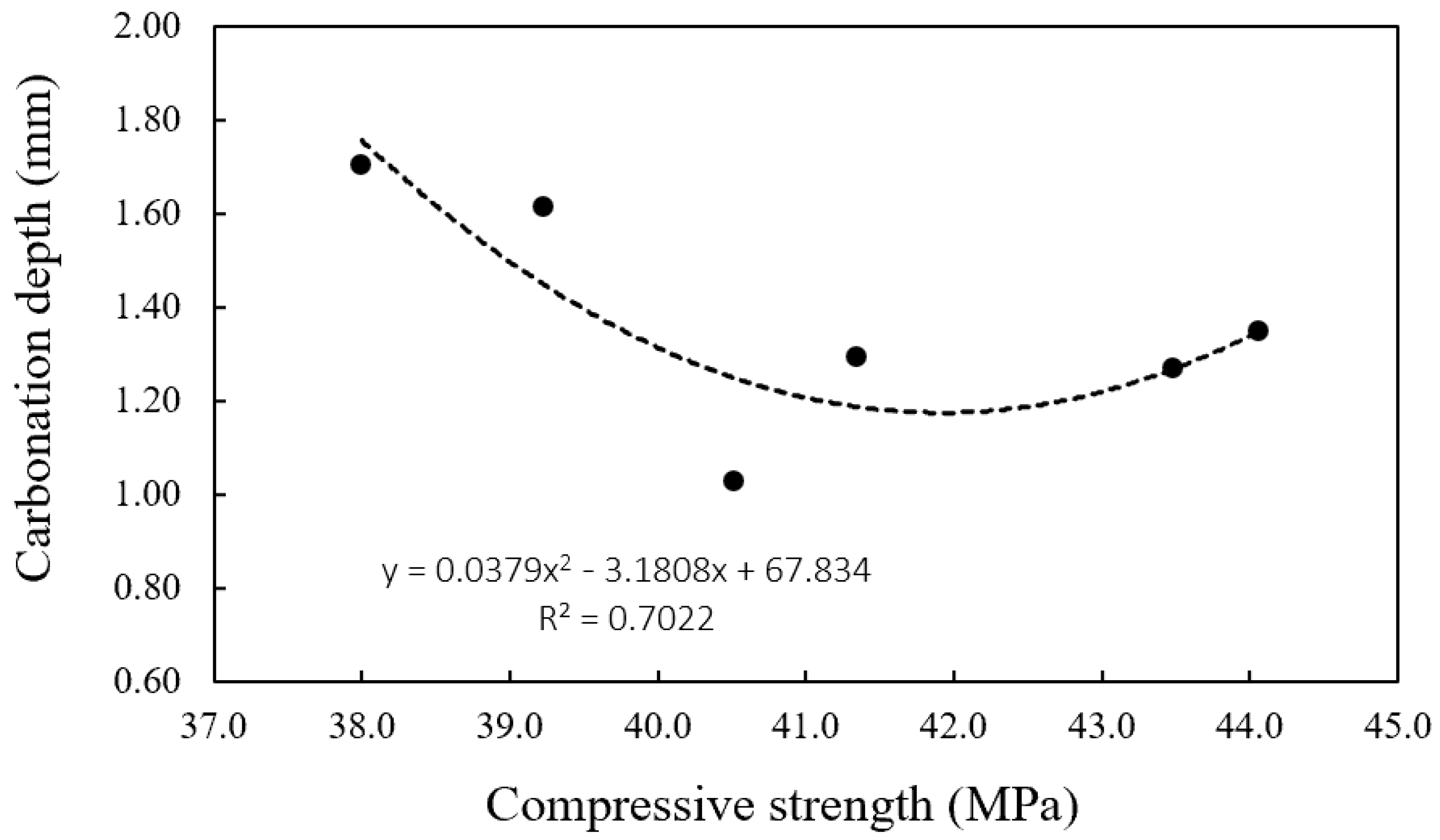

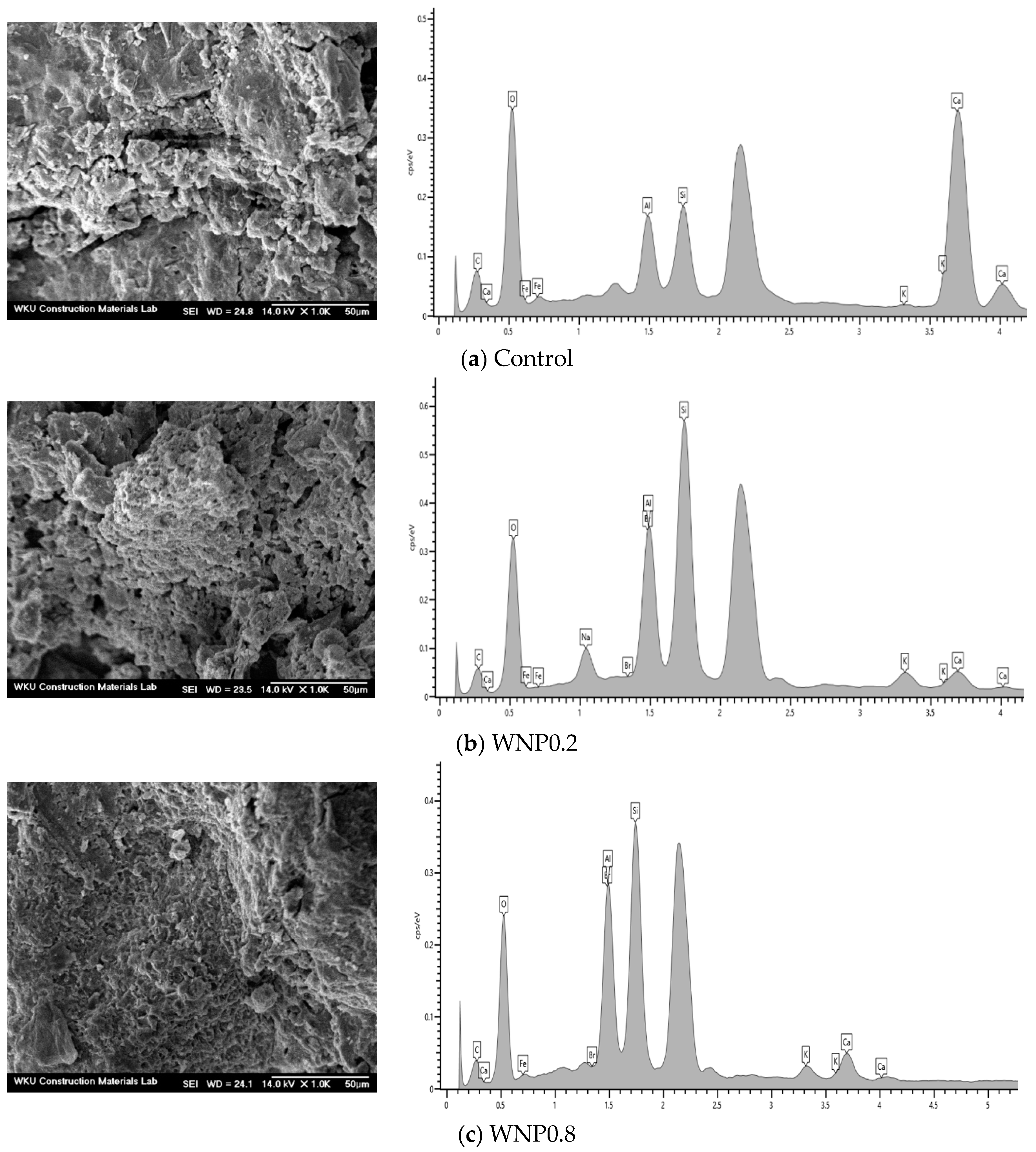
| Type | SiO2 | Al2O3 | Fe2O3 | CaO | MgO | K2O | Blaine (cm2/g) | Density (g/cm3) |
|---|---|---|---|---|---|---|---|---|
| Ordinary Portland cement | 17.43 | 6.50 | 3.57 | 64.40 | 2.55 | 1.17 | 3430 | 3.15 |
| Type | C | O | Si | Al | Ca | K |
|---|---|---|---|---|---|---|
| Ground waste newspaper (WNP) | 40.6 | 38.3 | 9.5 | 9.0 | 2.3 | 0.3 |
| Type | Fineness Modulus | Density (g/cm3) | Water Absorption (%) |
|---|---|---|---|
| Natural sand (NS) | 2.45 | 2.60 | 1.0 |
| Mix | W/B (%) | S/a * (%) | WNP ** (C *%) | Water (kg/m3) | Cement (kg/m3) | NS (kg/m3) | WNP (kg/m3) |
|---|---|---|---|---|---|---|---|
| Control | 50 | 42 | 0 | 170 | 340.0 | 739 | 0 |
| WNP0.2 | 0.2 | 339.3 | 0.7 | ||||
| WNP0.4 | 0.4 | 338.6 | 1.4 | ||||
| WNP0.6 | 0.6 | 338.0 | 2.0 | ||||
| WNP0.8 | 0.8 | 337.3 | 2.7 | ||||
| WNP1.0 | 1.0 | 336.6 | 3.4 |
| Mix | Element | Weight (%) | б |
|---|---|---|---|
| Control | O | 44.88 | 55.37 |
| Ca | 24.55 | 12.09 | |
| C | 14.49 | 23.82 | |
| Si | 4.24 | 2.98 | |
| Al | 4.01 | 2.93 | |
| K | 0.26 | 0.13 | |
| WNP0.2 | O | 38.12 | 40.52 |
| Ca | 2.82 | 1.19 | |
| C | 28.03 | 39.68 | |
| Si | 16.45 | 9.96 | |
| Al | 8.81 | 5.55 | |
| K | 2.19 | 0.95 | |
| WNP0.8 | O | 39.5 | 45.05 |
| Ca | 4.2 | 1.92 | |
| C | 21.4 | 32.54 | |
| Si | 16.0 | 10.41 | |
| Al | 10.7 | 7.25 | |
| K | 1.9 | 0.86 |
Disclaimer/Publisher’s Note: The statements, opinions and data contained in all publications are solely those of the individual author(s) and contributor(s) and not of MDPI and/or the editor(s). MDPI and/or the editor(s) disclaim responsibility for any injury to people or property resulting from any ideas, methods, instructions or products referred to in the content. |
© 2023 by the authors. Licensee MDPI, Basel, Switzerland. This article is an open access article distributed under the terms and conditions of the Creative Commons Attribution (CC BY) license (https://creativecommons.org/licenses/by/4.0/).
Share and Cite
Lee, J.-I.; Kim, C.-Y.; Yoon, J.-H.; Choi, S.-J. Mechanical Properties of Cement Mortar Containing Ground Waste Newspaper as Cementitious Material. Materials 2023, 16, 1374. https://doi.org/10.3390/ma16041374
Lee J-I, Kim C-Y, Yoon J-H, Choi S-J. Mechanical Properties of Cement Mortar Containing Ground Waste Newspaper as Cementitious Material. Materials. 2023; 16(4):1374. https://doi.org/10.3390/ma16041374
Chicago/Turabian StyleLee, Jae-In, Chae-Young Kim, Joo-Ho Yoon, and Se-Jin Choi. 2023. "Mechanical Properties of Cement Mortar Containing Ground Waste Newspaper as Cementitious Material" Materials 16, no. 4: 1374. https://doi.org/10.3390/ma16041374
APA StyleLee, J.-I., Kim, C.-Y., Yoon, J.-H., & Choi, S.-J. (2023). Mechanical Properties of Cement Mortar Containing Ground Waste Newspaper as Cementitious Material. Materials, 16(4), 1374. https://doi.org/10.3390/ma16041374







